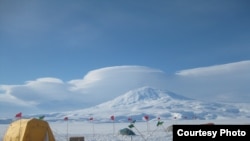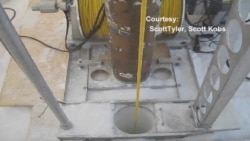The huge glaciers along the coast of Antarctica are keeping sheets of ice from flowing into the ocean. But as the climate warms, those glaciers start to melt, raising sea level and flooding coastal areas around the world.
So University of Nevada hydrology professor Scott Tyler set out to measure the conditions underneath the Ross Ice Shelf, a plain of floating ice in West Antarctica larger than Germany.
“If we raise sea level another meter or two very quickly, then we are going to see a lot more disruption and impact to our infrastructure, things like airports and sewage treatment plants," Tyler said, explaining that his goal "is to provide kind of an early warning system, a monitoring system of these shelf glaciers. It is easy. It doesn’t require a lot of instrumentation that is frozen into the ice."
His team is monitoring Antarctic ice melt using a fiber optic cable like the one attached to a television set or computer. It is dropped down a hole through the Ross Ice Shelf to the ocean below.
"We toss a little bit of light down an optical fiber and for several kilometers that light goes down the fiber and we look at the scattering [of light] that comes back, and I can then tell you pretty much every second, every meter along the fiber, or sometimes every 10 centimeters, what the temperature is every second, everywhere all the time.”
Cable sunk 200 meters through ice
Researchers - including an oceanographer from New York University and a glaciologist from Ohio State University - set up a base camp on the ice shelf. The plan was to drill 200 meters through the ice and then extend the cable 700 meters into the ocean under the shelf.
Tyler says in the harsh Antarctic climate, the scientists had to work fast.
“The ice shelf temperature is cold. It is minus 23 C (Centigrade). So, it is very cold ice. So the ocean wanted to freeze. And so we calculated that we had about at minimum 20 minutes of time to get everything down this little, tiny 50-millimeter diameter hole into the ocean before it would freeze solid. And, we did!”
That cable, by the way, is as thin as a human hair, but encased in a steel tube to protect it from ocean pressure.
Once it was plugged in to the instruments on the surface, images began to appear on the computer screen of what was happening below.
Data monitored remotely
Tyler describes the work in "Research Letters," a journal of the American Geophysical Union. He says data flowed almost continuously for 14 months, powered by solar and wind energy.
“We collected for the first few months eight times a day, and then we cut it back down once we got into winter to conserve power,” he said.
The scientists monitored the data remotely from the comfort of their offices in the United States using a satellite modem, which wasn’t speedy Tyler says.
“It is probably a little like when they are working the Mars Rover. It takes a long time to get any information back and forth, but it worked generally most of the time,” he said.
Funded by the National Science Foundation, the project proved that the technology works. While satellites can and do chart changes in ice shelves from space, the advantage of fiber optics is that it can record those changes in detail in real time on location under the ice, and Tyler hopes to build a network of such stations across the Ross Ice Shelf and on other big glaciers.













